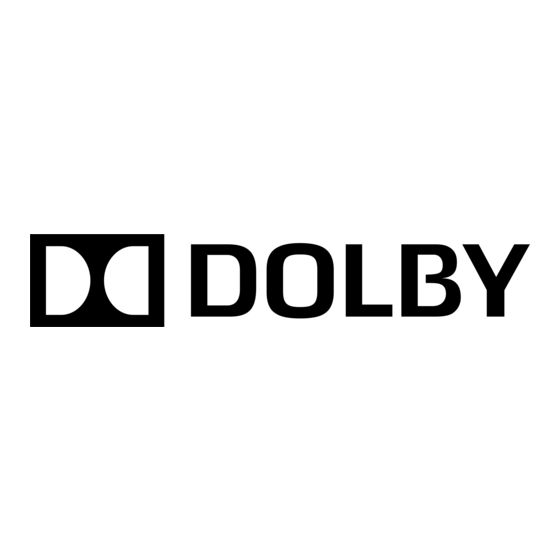Advertisement
Quick Links
Advertisement

Summary of Contents for Dolby Laboratories Atmos
- Page 1 ® Dolby Atmos for the Home Theater October 2014...
- Page 2 This white paper is designed to explain how Dolby Atmos will work in home theaters and how you can build a Dolby Atmos enabled system or upgrade your existing system to support Dolby Atmos.
- Page 3 Dolby y Atmos obje ect-based so oundtracks. The resu ult of that in tense collab boration, Do olby Atmos, debuted in...
- Page 4 The flexibility of Dolby Atmos object-based sound makes it incredibly adaptable. A Dolby Atmos movie can be played back on nearly any speaker configuration in the home. You’ll be able to hear the placement and movement of sound in a Dolby Atmos movie whether you have a system with five speakers on the floor and two overhead, or 24 speakers on the floor and 10 overhead (the current maximum for a Dolby Atmos supersystem).
- Page 5 Dolby Atmos audio tracks (both Dolby TrueHD and Dolby Digital Plus) are backward compatible. If you play a movie mixed in Dolby Atmos on a non Dolby Atmos system, you’ll experience traditional 5.1 or 7.1 audio, depending on the layout of your system. This means content providers don’t need to maintain separate Dolby Atmos and non Dolby Atmos...
- Page 6 Figure 2: D Dolby Atmos en nabled speaker rs reflect sound d off the ceilin g to produce a an incredibly lif felike re-creatio on of overhead s sound.
- Page 7 These include only the upward-firing elements. You can place these add-on modules on top of your current speakers or on a nearby surface. Figure 4: You can place Dolby Atmos enabled add-on speaker modules on top of or near your existing traditional speakers.
- Page 8 If you opt to use only two Dolby Atmos enabled speakers, you’ll still get a very immersive experience, with sounds moving overhead. Simply place the Dolby Atmos enabled speakers at the front left and front right speaker locations.
- Page 9 You can a two Dolb by Atmos en nabled speak kers and ge et detailed o overhead sou und without t going to th trouble o...
- Page 10 adds a number at the end to specify the number of overhead or Dolby Atmos enabled speakers you use (for example, 7.1.4). The following figures show the most common speaker layouts in a Dolby Atmos system for home theater.
- Page 11 There is one important consideration in expanding your system: new speakers must be added to your Dolby Atmos system in pairs. A new speaker on the right side of the room must be matched by a similar speaker on the left side of the room. This is true for speakers located on the floor as well as overhead.
- Page 12 The technological building blocks of Dolby Atmos Initially, you’ll be able to play Dolby Atmos content from a Blu-ray Disc or from a streaming video service. Eventually, cable, terrestrial, and digital broadcast systems as well as video game consoles will be capable of providing Dolby Atmos content.
- Page 13 Atmos sound. This substream represents a losslessly encoded fully object-based mix. Dolby Atmos in Dolby TrueHD is transmitted from a Blu-ray player to your AVR via an HDMI connection. If your AVR supports Dolby Atmos, the Dolby TrueHD object-based audio and related metadata will be decoded, processed, and rendered to your specific speaker configuration.
- Page 14 Dolby Atmos, we have expanded this technology to support encoding of Dolby Atmos content as lossless pulse-code modulation (PCM) audio. A key benefit of Dolby MAT 2.0 is that Dolby Atmos object audio can be live encoded and transmitted from a source device with limited latency and processing complexity. Among the possible sources are broadcast set-top boxes and game consoles.
-
Page 15: Dolby Surround Upmixer
Dolby surround upmixer If you invest in building a Dolby Atmos home theater, you want to get full use of it, even if the content you’re playing isn’t mixed in Dolby Atmos. That’s where the Dolby surround upmixer comes in. - Page 16 Translating cinematic Dolby Atmos content to the home As we’ve noted, Dolby Atmos allows each sound in a movie scene to be represented as a separate audio object. And each of these objects has its own metadata describing precisely where it should originate and how it should move, among other data.
- Page 17 Production houses that create Dolby Atmos content for home theaters will use a tool called Dolby Media Producer, along with its suite of professional encoding, decoding, and media- related tools. Before using Dolby Media Producer, though, production houses have the option to perform several preliminary steps, including a near-field remix and remastering of the cinematic master file.
- Page 18 Dolby, Dolby Atmos, Pro Logic, and the double-D symbol are registered trademarks of Dolby Laboratories. Dolby Digital Plus is a trademark of Dolby Laboratories. All other trademarks remain the property of their respective owners. © 2014 Dolby Laboratories, Inc. All rights reserved. S14/28273/28307 ...


Need help?
Do you have a question about the Atmos and is the answer not in the manual?
Questions and answers